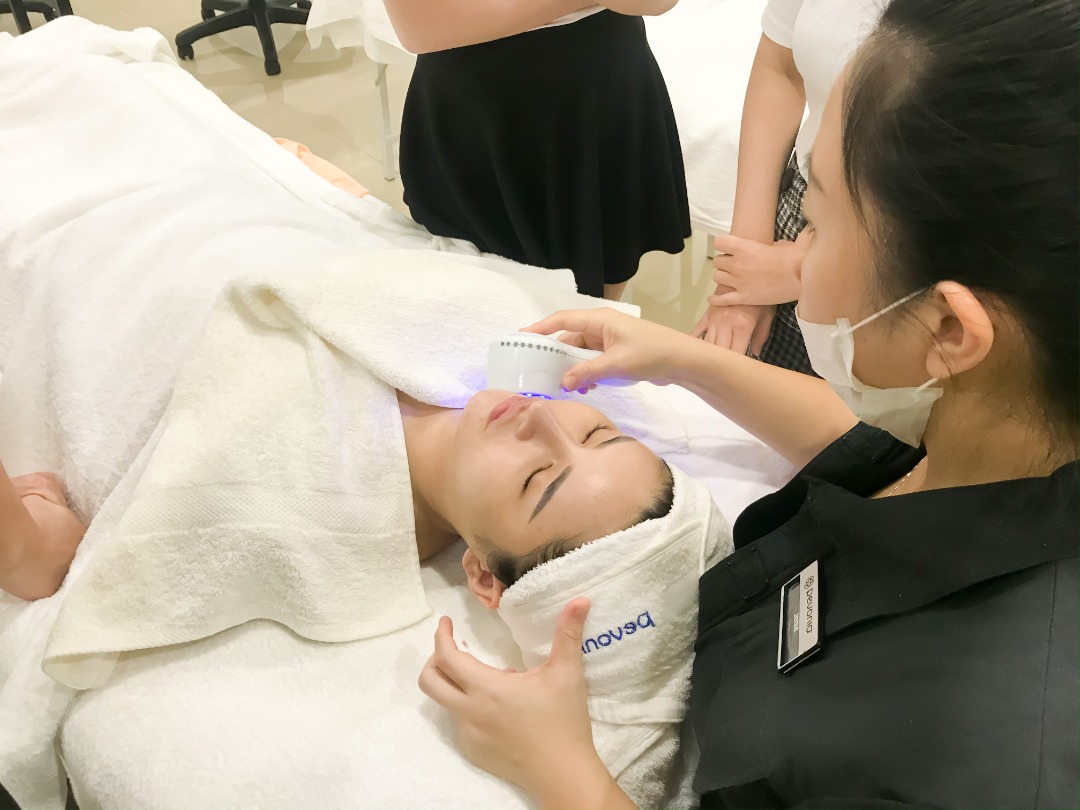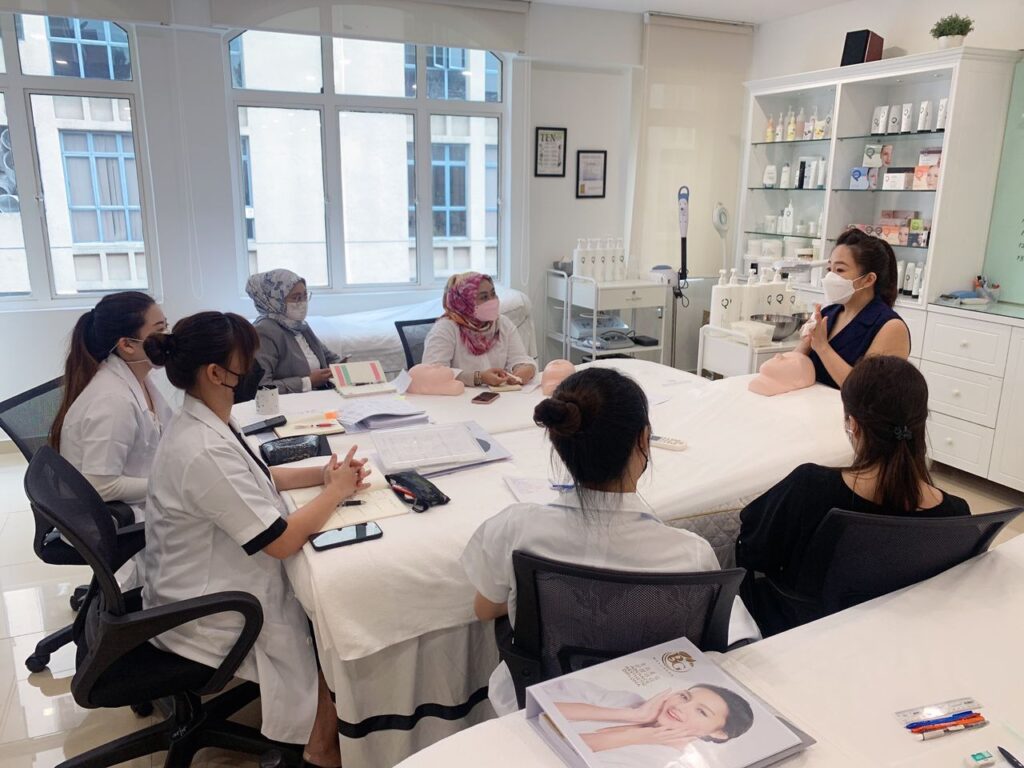HOME > ACADEMICS > PROFESSIONAL ESTHETICIAN DIPLOMA
PROFESSIONAL ESTHETICIAN DIPLOMA



Course Contents
PROFESSIONAL ESTHETICIAN DIPLOMA
This Professional Esthetician Diploma Course is designed to provide comprehensive training in skincare, beauty treatments, waxing, machines, and makeup. The goal of the program is to equip students with the knowledge and skills necessary to pursue a successful career as a licensed esthetician. Students will acquire both theoretical knowledge and practical skills essential for a successful career in the beauty industry.
✔ Skin anatomy and diagnosis
✔ Customer service and consultation skills
✔ Understanding skin problems and diseases
✔ Skin aging and prevention
✔ Sensitive skin causes and solutions
✔ Addressing adult and teen acne
✔ Welcome massage technique
✔ Professional hands-on skills
✔ Exfoliation and extraction skills: comedones and pustules
✔ Comprehensive massage techniques (face, eye, decollete, shoulder)
✔ Professional mask application technique
✔ Serum and ampoule application technique
CERTIFICATES:
✔ BG International College (Diploma in Professional Esthetician)
✔ SKM
✔ CIDESCO Certificate
Course Duration
Course Fees
Frequently Asked Questions
The Professional Esthetician Diploma Course at BG International College aims to teach students important knowledge and skills. These are necessary for a successful career in the beauty and skincare industry. These are essential for a successful career in the beauty and skincare industry. The program includes many topics.
These topics are skin anatomy, skincare treatments, waxing, makeup, and beauty machines. The course combines theory with hands-on experience. This helps students tackle different skin issues. They learn to give personalized consultations and provide professional beauty services.
The Professional Esthetician Diploma Course at BG International College covers a comprehensive range of topics essential for aspiring estheticians. The curriculum includes:
- Skin Anatomy and Diagnosis – Understanding the structure and function of the skin to provide tailored treatments.
- Customer Service and Consultation Skills – Techniques to assess and consult clients effectively.
- Skin Conditions – Identifying and addressing common issues like acne, aging, and sensitive skin.
- Exfoliation and Extraction – Techniques for removing dead skin cells and impurities, such as comedones and pustules.
- Comprehensive Massage Techniques – Face, eye, decollete, and shoulder massage techniques to improve client relaxation and skin health.
- Mask, Serum, and Ampoule Application – Professional methods for applying skincare products.
- Waxing – Hair removal techniques using waxing treatments.
- Makeup and Beauty Machine Usage – The application of makeup and using machines for beauty treatments.
This curriculum prepares students with both theoretical and practical skills for a successful career in esthetics.
The Professional Esthetician Diploma at BG International College equips students for a successful career in the beauty industry by providing both theoretical knowledge and hands-on practical skills. Key ways the program prepares students include:
- Comprehensive Training: The course covers essential topics such as skin anatomy, skincare treatments, waxing, and makeup, enabling students to master a wide range of beauty techniques that are in demand in the industry.
- Practical Skills: Students gain experience with advanced techniques like exfoliation, extraction, massage, and the use of skincare products such as masks, serums, and ampoules. They also learn how to operate beauty machines, making them proficient with tools that are widely used in modern salons.
- Client Consultation & Customer Service: Emphasis on consultation and communication skills ensures that students can effectively engage with clients, understand their needs, and provide personalized beauty solutions.
- Industry Certifications: Graduates receive certifications such as the BG International College Diploma, SKM, and CIDESCO Certificate, enhancing their credibility and employability in the global beauty market.
These elements collectively ensure that students are well-prepared to meet industry standards and build successful careers in the beauty and wellness sector.
Upon completion of the Professional Esthetician Diploma at BG International College, students receive the following certificates:
- BG International College Diploma in Professional Esthetician – This certifies the completion of the comprehensive esthetician training program.
- SKM (Sijil Kemahiran Malaysia) – A national skills certification in Malaysia, which enhances the credibility of graduates in the local industry.
- CIDESCO Certificate – A globally recognized certification from the Comité International d’Esthétique et de Cosmétologie, which is highly regarded in the international beauty industry.
These certifications equip graduates with credentials that are valuable both locally and internationally.
Skin anatomy and diagnosis are crucial aspects of esthetician training for several reasons:
- Customized Treatment Plans: Understanding skin anatomy helps estheticians assess each client’s skin type and condition accurately, allowing them to create personalized treatment plans. This ensures that the treatments and products used are safe and effective for each individual’s unique skin concerns, whether it’s acne, hyperpigmentation, or aging.
- Effective Problem-Solving: Knowledge of skin layers and functions aids estheticians in diagnosing common skin issues like dryness, oiliness, or sensitivity. By understanding the root causes of these problems (e.g., clogged pores or damaged skin barriers), estheticians can recommend targeted treatments that address these underlying factors.
- Preventing Skin Damage: A thorough grasp of skin anatomy helps estheticians avoid improper treatments that could harm the skin, such as using overly aggressive peels or extractions on sensitive or thin skin types. This reduces the risk of side effects like irritation, scarring, or infections.
- Client Trust and Confidence: Clients are more likely to trust professionals who can explain the science behind their treatments. By demonstrating expertise in skin anatomy and diagnosis, estheticians can build stronger relationships with clients and enhance their credibility in the beauty industry.
In summary, skin anatomy and diagnosis form the foundation of safe, effective, and personalized skin care practices, making them critical components of esthetician training.
Customer service and consultation skills are emphasized through various approaches:
- Practical Training: The program includes hands-on training where students practice real-life scenarios involving client interactions. This helps them develop effective communication skills and learn how to handle diverse client needs.
- Role-Playing Exercises: Students engage in role-playing exercises to simulate client consultations. This practice is crucial for learning how to assess client needs, recommend appropriate treatments, and handle any concerns or questions clients may have.
- Client Management: The curriculum covers techniques for building strong client relationships, including how to maintain professionalism, manage client expectations, and provide exceptional service.
- Feedback and Evaluation: Students receive feedback from instructors and peers on their client interactions, helping them refine their consultation skills and improve their overall customer service approach.
- Industry Standards: The program integrates industry best practices and standards for client service, ensuring that students are well-versed in the latest trends and expectations in the esthetics field.
These components work together to ensure that graduates are equipped with the necessary skills to deliver outstanding customer service and conduct effective consultations in.
In the Professional Esthetician Diploma program, students typically learn about a range of skin problems and diseases, including:
- Acne: Understanding different types of acne, such as cystic and hormonal acne, and how to treat and manage them with appropriate skincare treatments and products.
- Rosacea: Identifying the signs of rosacea, including redness and visible blood vessels, and learning to recommend treatments that can help manage symptoms and reduce flare-ups.
- Eczema and Dermatitis: Recognizing various forms of eczema and dermatitis, including atopic dermatitis, and learning how to provide soothing and non-irritating treatments.
- Psoriasis: Understanding psoriasis, characterized by red, scaly patches, and how to offer treatments that help alleviate symptoms.
- Hyperpigmentation: Addressing issues like age spots, melasma, and sunspots, and learning techniques for reducing pigmentation through treatments and products.
- Hypopigmentation: Dealing with conditions like vitiligo, where skin loses pigment, and exploring options for managing and treating these areas.
- Sun Damage: Identifying signs of sun damage, such as premature aging and sunburn, and providing treatments to repair and protect the skin.
- Skin Sensitivities: Learning about various skin sensitivities and allergies, and how to adapt treatments to accommodate clients with sensitive skin.
- Pre-cancerous Conditions: Understanding signs of skin changes that could indicate pre-cancerous conditions and knowing when to refer clients to a dermatologist.
- Skin Aging: Addressing concerns related to skin aging, such as wrinkles and loss of elasticity, and providing treatments that promote a youthful appearance.
By covering these conditions, the program ensures that students are equipped to recognize, address, and manage a wide range of skin issues in their professional practice.
The topics of skin aging, prevention, and sensitive skin concerns are typically addressed through a combination of theoretical knowledge and practical application:
Skin Aging:
- Causes & Signs: Students learn about factors like collagen loss and signs such as wrinkles and sagging.
- Treatments: Includes anti-aging facials, microdermabrasion, chemical peels, and product recommendations.
- Prevention: Focuses on sunscreen use, antioxidants, and healthy lifestyle choices.
Sensitive Skin Concerns:
- Identifying Issues: Understanding various sensitivities like redness and irritation.
- Gentle Treatments: Using non-irritating products and techniques.
- Ingredient Knowledge: Awareness of beneficial and harmful ingredients.
- Client Consultation: Customizing treatments based on individual sensitivities.
Overall, the program combines theoretical knowledge with practical skills to prepare students to effectively address and manage skin aging, prevention, and sensitive skin concerns in their practice.
In the Professional Esthetician Diploma course, hands-on skills are a crucial component and include:
- Facial Treatments: Techniques for performing cleansing, exfoliating, and hydrating facials tailored to different skin types and conditions.
- Chemical Peels: Application and management of various chemical peels to treat issues like acne and hyperpigmentation.
- Microdermabrasion: Using microdermabrasion equipment to exfoliate the skin and improve texture.
- Hair Removal: Skills in waxing and other hair removal techniques for different areas of the body.
- Massage Techniques: Facial and body massage techniques to enhance relaxation and skin health.
- Skin Analysis: Conducting thorough skin assessments to determine appropriate treatments and products.
- Product Application: Proper application of skincare products, including serums, masks, and moisturizers.
- Client Consultations: Conducting consultations to understand client needs and customize treatments.
These practical skills ensure students are well-prepared to perform a range of esthetic services professionally.
The Professional Esthetician Diploma program incorporates comprehensive massage techniques and professional mask application through the following methods:
Massage Techniques:
- Training Modules: Detailed instruction on various facial and body massage techniques, including Swedish, deep tissue, and lymphatic drainage massages.
- Hands-On Practice: Students practice these techniques in simulated environments to develop proficiency and adapt methods to different client needs.
- Anatomy Knowledge: Understanding of facial and body anatomy to ensure effective and safe application of massage techniques.
- Integration with Treatments: Learning how to incorporate massage into broader facial and body treatments to enhance overall results.
Professional Mask Application:
- Mask Types: Instruction on different types of masks (e.g., hydrating, purifying, soothing) and their specific benefits for various skin types and conditions.
- Application Techniques: Training on proper application methods, including preparation, application, and removal to ensure maximum efficacy and client comfort.
- Customization: Learning how to select and customize masks based on individual skin assessments and client needs.
- Practical Sessions: Hands-on practice applying masks in a professional setting, allowing students to refine their techniques and understand the interaction between masks and other skincare treatments.
These components ensure students are well-equipped to deliver effective and professional massage and mask treatments in their practice.
